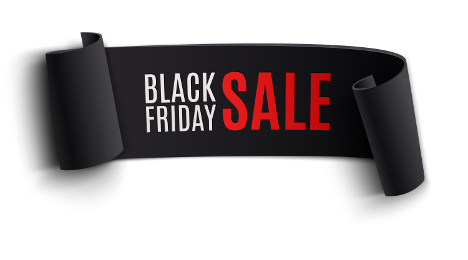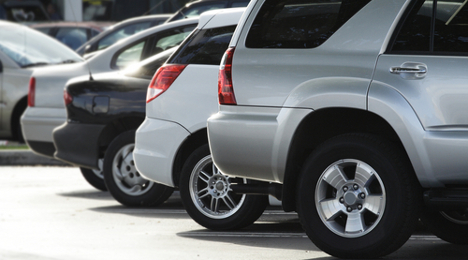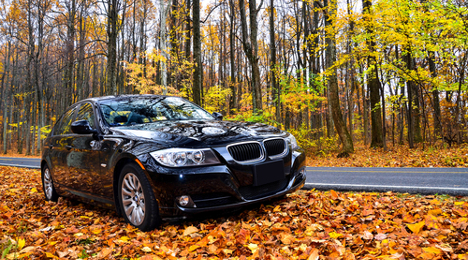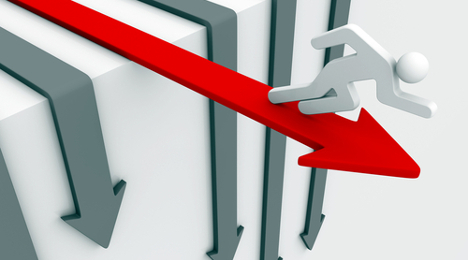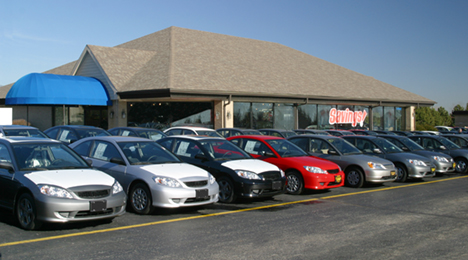Black Friday isn’t just for heavily discounted electronics. The discounts are ramping up on the showroom floors, as well.
For franchised dealers looking to push the season’s best deals, Kelley Blue Book released a list of the 10 best new-car steals for November.
“Black Friday represents one of the hottest shopping days in America, and new-car shopping is no exception; there are amazing deals on new cars right now as the calendar year comes to a close,” said Jack Nerad, executive editorial director and executive market analyst for Kelley Blue Book’s KBB.com. “This month's deals include some 2015 models and some outgoing 2014s, compact sedans, midsize sedans, and even a sporty three-row SUV. Topping the list is a roomy midsize sedan with distinct European flair and a new turbo engine that's both fun and efficient.”
One of the top lease deal for the month goes to the Cadillac ATS, which is being offered for $299 on a 36-month term with only $749 down.
Or how about the Chevrolet Malibu, which is being offered for lease at $189 per month with a down payment of $2,119 on a 36-month term.
Moving along to highlight one of the top financing deals of the month, shoppers can buy a 2014 Volkswagen Passat at zero percent financing for 60 months.
There are also significant cash-back deals that may be enticing for consumers. For example, shoppers purchasing a 2014 Nissan Altima can receive $1,000 cash back, plus zero percent financing for 60 months.
KBB.com also offers full coverage of its Best Car Deals of the Month, including editorial comments about each model, specific deal expiration dates, vehicle photography, pricing details and reviews.
It could be a whopper of a month for used-vehicle sales, if a forecast from TrueCar bears out. The company is calling for nearly 3.1 million used-vehicle sales by the end of November.
Specifically, TrueCar’s estimate is for the used market — including franchised and independent dealers plus private-party transactions — to exceed 3,079,327 sales this month, which would beat year-ago figures by 23.7 percent.
Comparatively, Edmunds.com released a forecast on Monday predicting an estimated 2.64 million used sales for November.
Edmunds also projected a used-car SAAR of 36.3 million for the current month.
As for the coming months, the market could be in store for a solid winter.
In analysis earlier this month that recapped October used-vehicle sales — which showed a modest year-over-lift — CNW Research offered a glimpse at where used sales figures could end up in early 2015.
“The number of used-car shoppers (including those who were considering either a new or used vehicle) slipped more than 6.8 percent versus a year ago, but rose by a similar amount versus September,” CNW Art Spinella said, referring to October. “The latter is interesting because total number of sales were down on a higher number of shoppers.
“Indication: Expect a strong January-March used-sales market because shoppers typically are two to three months away from actually making a purchase,” he added.
Expect monthly used-vehicle sales for November to end up a good bit softer than they were in October, but the seasonally adjusted annualized rate should actually be about 2 percent higher.
An Edmunds.com analysis released Monday is predicting an estimated 2.64 million used sales for November, down from 2.96 million in October.
However the used-car SAAR is projected at 36.3 million for the current month, versus 35.6 million last month.
Drilling down into that November projection, 878,000 of those 2.64 million used sales expected for the month are via franchised dealers, according to data that Edmunds shared with Auto Remarketing. And certified pre-owned sales are expected to command approximately a 22.5-percent share of franchised dealer used sales for the month, with about 197,000 units sold.
This forecast comes a week after Edmunds released its Q3 2014 Used Vehicle Market Report, which provided a fairly in-depth look at how used-vehicle sales performed in the first three quarters of the year.
Total used sales through three quarters were at 27.89 million, down 0.2 percent year-over-year, Edmunds said in the report. For franchised dealers, in particular, they were up 3.9 percent at 8.59 million.
In the third quarter, there were 9.16 million total used sales (down 0.4 percent year-over-year) and 2.97 million used sales by franchised dealers (up 3.7 percent).
In the report, Edmunds also took a close look at the certified pre-owned segment and its role at franchised dealerships.
A recent report from Requisite Press showed that used cars are still most often the fiscally responsible way to go for the majority of American families.
According to the October 2014 Auto Buyer’s Affordability Index (ABAI), which is currently at 54.1, a "prudent, median-income household" can only afford 54.1 percent of the new-car average price.
That said, transaction prices have recently begun to weaken — and the company expects that new-car prices may be headed more into the realm of affordability for the majority of households if the rate of income continues to grow.
But recent trends also come with some drawbacks. According to Requisite Press, auto loan interest rates can be expected to increase as the continued financing risk continues to rise, which will tighten credit as the post-recession limits are reached. Consequently, consumer spending will most likely be reduced.
That said, Requisite Press forecasts the possibility that income growth may begin, for the first time in 35 years, to outpace new-car price growth.
“New-car affordability is likely to improve in the coming days if we can avoid an income slowdown,” Phil Kelton, president of Requisite Press, said. “The selection of affordable models is best increased by competition, but a sustained improvement in affordability will certainly give it a boost.”
While, according to Requisite Press’ numbers, the average responsible family cannot afford the premium associated with a new vehicle, that does not seem to have much effect on the more than 16 million new cars projected to be sold by the end of this year. And with 2015 expected to outpace that and reach maybe even 17 million units, it may lead one to wonder what the long term effects will be on both the new- and used-car industries.
What do you think of the increasing numbers of new cars being injected into the system? Do you think they will invigorate or encumber the used-vehicle industry? Let us know in the comments or tweet us @autoremkting.
There has been a lot of talk, as new automotive sales continue to increase, about what the overall sales number will be for this year. TrueCar forecasts total sales for the year will reach 16.4 million units — the best since 2007 — and could possibly reach toward 17 million units in 2015 if economic conditions continue to improve.
And as some predict that the demand for automotive products has nearly reached its peak, John Krafcik, TrueCar’s president, believes all manufacturers still have quite a bit of room for improvement. Presenting at the Automotive Press Association last week in Detroit, Krafcik outlined four key areas, coined as “super segments,” which cover four specific revenue streams associated with four product categories.
The four segments – mass-market cars, mass-market utilities, pickup trucks and premium brand vehicles (all types) – are what Krafcik believes manufacturers should be focusing on, because, according to him, no one is dominant in all four areas.
“For individual automakers the revenue mix across the four super segments varies considerably,” Krafcik said. “Some are overly reliant on mass-market cars – notably Volkswagen Group and Hyundai-Kia – while others are significantly over-weighted in pickup and utility segments, such as Fiat Chrysler. Remarkably, no automaker has a revenue mix even close to the consumer-driven industry mix.”
Krafcik recommends that those evaluating the industry should, instead of just looking at units sold, focus on the revenue streams. The market, based on TrueCar’s data, is forecasted to generate $521.5 billion in revenue by the end of the year, compared to $292 billion in 2009. Here are several other key observations, according to the company:
- From 2009 to 2014, total U.S. auto industry revenue growth of at least 79 percent is outpacing the 58 percent unit growth forecast for the same period.
- That trend should continue into 2015 as economic growth continues and the price of fuel remains relatively stable.
- Looking solely at industry volumes, without factoring in the richer margins and revenue generated by three of the four vehicle segments, masks how truly robust the industry is.
- During the 2009 to 2014 period, pickups and mass-market utilities, which deliver higher transaction prices and margins than mass-market cars, increased their share of industry revenue to 50 percent from 44 percent.
- Industry trends point to stabilization in revenue mix, though not unit mix, comprised of 30 percent mass-market car (“three-box'' vehicles); 30 percent utility (“two-box'' vehicles); 20 percent pickup; and 20 percent premium vehicle.
What do all the numbers suggest? According to Krafcik, there is a significant economic opportunity for each of the major players in the automotive industry to broaden their portfolios and potentially realign themselves with other manufacturers, whether it be through mergers, acquisitions, partnerships, etc. to create more “revenue-balanced OEM groups.”
There’s been a lot of chatter recently in regards to the growing number of lease returns and its impact on used-car prices. It is true that there are a great deal of leases returning – an expected figure near 2.1 million vehicles for 2014 before the year is over, according to Manheim data.
There is a fear, in some minds, that too many lease returns are putting downward pressure on used-vehicle prices.
But that is just a small slice of the story, according to Swapalease.com’s executive vice president Scot Hall.
“It’s easy to point a finger at leasing when it comes to falling car prices simply because there has been a great resurgence in lease deals since the recession,” Hall said. “However, when you go from 10 million SAAR to 16 million SAAR, there’s a great resurgence all around, not just leasing. It’s difficult to congratulate leasing in helping you get to 16 million SAAR and then also say it’s hurting the industry by forcing falling auto prices.”
Swapalease.com also points out several other factors to consider when thinking about the over 2 million vehicles expected to return from their leases this year:
- Between 8-9 million trade-ins, overall, are expected in 2014 (per industry average)
- Leasing, according to previous numbers, will account for just 22.5 percent of vehicles coming back into dealerships this year
- Lease return vehicles (3-year-old) are actually helping to fuel the CPO recovery
What is your outlook on this topic? Let us know in the comments or tweet us @autoremkting.
This month is likely to end with nearly 3.2 million used vehicles sold during October, which would beat year-ago figures by 1.3 percent, according to projections in CNW Research’s latest Retail Automotive Summary.
CNW’s data includes sales forecasts for franchised and independent dealers as well as private-party numbers. Of those three groups, private-party sales are projected to grow the most from October 2013 with a 12.2 percent spike.
CNW is calling for 882,885 casual sales, which would push the year-to-date sum to 10.77 million, a 3.3-percent hike over year-ago figures.
Meanwhile, franchised dealers will likely finish the month having moved 1.27 million used cars (up 4.3 percent) and its year-to-date used sales tally at 13.23 million (up 0.1 percent).
The firm is forecasting independent dealer used sales of 1.05 million, a 9.2-percent slide. This would result in a 10-month sum of 11.65 million (down 2.6 percent).
Elsewhere, Edmunds.com estimated that there would be 2.96 million used sales for October and a used SAAR of 35.6 million.
TrueCar was calling for 3.08 million used sales, which would be a 2.8-percent year-over-year increase, according to its figures.
During its third-quarter conference call, Sonic Automotive highlighted several all-time records, including those set for new retail unit sales, pre-owned gross profit and third quarter total gross profit.
When asked if something was happening to separate Sonic from the pack during its strong quarter and used-vehicle sales increase of about 5 percent on the same-store side, Scott Smith, the company’s president and chief strategic officer, attributed the steady increase to his dealers’ consistent inventory levels, which have traditionally been light.
“I just think that with the great inventory management, our systems are running on a traditionally, versus the rest of the world, light day supply of 25-27 days,” Smith said. “If you go back and look at our performance, we just haven’t had those inventory pressures that caused those kind of adjustments. You’ve got to remember there are 42-45 million used cars sold every year and what makes a group go up and down, or a dealer go up and down, is just getting their inventory out of whack. We just haven’t had that kind of pressure here in a while.”
And, according to Smith, he doesn’t think they will face that kind of pressure again, due to his faith in Sonic’s digital inventory management systems. Smith also believes the sales will retain their consistency for the foreseeable future.
“I think the used-car business is pretty solid,” Smith said. “Our volume is decent. We sold 90 cars per rooftop, and we want to be at 100, but it wasn’t too bad. Our gross was good. Over $1,500 for us; that’s the highest it’s been in a while.”
When asked if they should be keeping higher inventory levels going into the coming months to drive sales, Jeff Dyke, Sonic’s executive vice president of operations, seemed to think that going into the winter months light is the way to go.
“You never want to have a heavy inventory coming out of July, August, September time frame,” Dyke said. “All the dealers start selling their cars in October, November and December, all the mom-and-pops and single dealership owners are clearing up inventory. You can see some of the bigger dealership groups doing that now, it’s a great time for us to buy. So you’ll see us push our inventory levels up in the fourth quarter.”
While remaining conservative with its inventory, and also continuing to test the waters with its EchoPark and One Sonic-One Experience, Smith remains optimistic, even hinting at further group growth.
“It wouldn’t surprise us at all that a couple more dealerships enter the Sonic family here in ’15,” Smith said. “That’s both from an acquisition and an add-point perspective.”
Dealers who participated in KeyBanc Capital Markets’ monthly automotive retail industry update survey gave some candid comments about their used-vehicle prospects, especially in light of 44 percent of respondents saying they expected gross profit per unit to soften by about $50.
Despite that gross-profit expectation, the vast majority of dealers surveyed in September (78 percent) told KeyBanc that they projected year-over-year used sales to rise this month. Of that amount, a third thought that sales would climb between 5 percent and 10 percent, while another third said that the increase would be up to 5 percent.
Among the comments KeyBanc shared, the perspective of used-car managers who participated in the firm’s monthly project covered a wide array of dealership elements, but many focused on inventory and gross profit.
“My inventory levels were just right. We re-price inventory on an ongoing basis, but our gross profit per unit is relatively stable,” one dealer said.
“We didn’t experience any impact. Our Inventory was good in 3Q, and we didn’t see any real impact,” another dealer stated.
“Maybe a couple hundred dollars lower than last year, but I’m new to this store,” yet another mentioned about gross profit.
The connection between inventory and gross profit continued in KeyBanc’s survey, which prompted analysts to say they “remain bullish on the outlook” for dealers.
“We could’ve used more cars, but gross profit per unit was about the same,” a dealer told analysts.
“A little pressure in prices, but no real push on our inventory position,” another dealer added.
One store shared about how what vehicles were on the lot didn’t give the dealership a good chance to succeed.
“Wrong kind of inventory. Too old. Too many miles,” the dealer said. “No impact on gross profit.”
Meanwhile, one dealer comment showed some recent successes — and the strategy of how the store obtained them.
“Our gross profit per unit went up $488 compared to last year,” the dealer said. “If a car doesn’t sell within 20 days, we immediately re-price. We don’t wait.”
The final two dealers who shared how their stores are performing with KeyBanc also touched on inventory.
“Not enough cars was our experience,” a dealer said. “We actually went up in gross profit — more than $100.”
The last dealer acknowledged, “Yes, prices are coming down, but not anymore than normal.”
Beyond the direct dealer comments, KeyBanc’s monthly survey also highlighted dealer sentiment about F&I gross profit, how subprime borrowers are being financed as well as elements of the new-vehicle department.
The majority of dealers surveyed (67 percent) told the firm that F&I gross profit is on track to increase by less than $50, while another 22 percent saw that figure softening by about $50.
A total of 56 percent of dealers indicated conditions for subprime financing was staying the same as only 11 percent saw finance companies tightening their underwriting for potential buyers in this credit tier.
Finally on the new-car side, 56 percent think gross profit per new model turned would be staying flat while the remainder split evenly between that figure increasing or decreasing by $50 or less.
A substantial portion of dealers surveyed (44 percent) said they see automaker stair-step incentive programs remaining stable while another 33 percent thought OEMs are ramping up these initiatives.
In an analysis released earlier this month, CNW said that September could have brighter days in store for the used-vehicle market following a rather tough August.
Seems CNW was right on the money with its predictions, as used-car sales this month will likely beat year-ago figures by more than 2 percent. But that is not the only positive sign for dealers in the used-car market this month: a hearty helping of off-lease and trade-in cars are pushing up used-vehicle inventory for dealers, who aren’t having to shell out as much money to get the used units they need.
CNW shed some light on these trends in its latest Retail Automotive Summary, which projected September to finish with 3.74 million used sales industry-wide.
That would be a 2.6-percent increase over September 2013 and push the year-to-date sum to 32.40 million, which is off a slight 0.2 percent from last year’s pace.
For the month, franchised dealers are expected to sell 1.45 million used vehicles (up 2.7 percent), and independents are forecasted to move 1.26 million used cars (up 1.8 percent). CNW is predicting 1.03 million private-party sales this month (up 3.3 percent).
Meanwhile, Edmunds.com is predicting 2.95 million used sales for the month with a used-car SAAR of 36.3 million.
Turning its attention to the pricing and supply side of the market, CNW discussed how a boost in supply and a drop in wholesale pricing is benefitting dealers’ used-car ops.
“Dealers are taking advantage of lower wholesale prices and the influx of both trade-ins and off-lease vehicles,” CNW president Art Spinella said in the report. “The result: On-lot inventories are swelling with the used days’ supply up 3.55 percent versus a year ago and above 47.6 days in inventory.
“These lower wholesale prices have sent franchised-dealer asking prices downward to $11,309 versus a year ago’s $11,729,” he continued. “For independent dealers, asking prices have dipped only slightly.”
Specifically, asking prices for independents in September were at $10,392, down from $10,437 a year ago.

